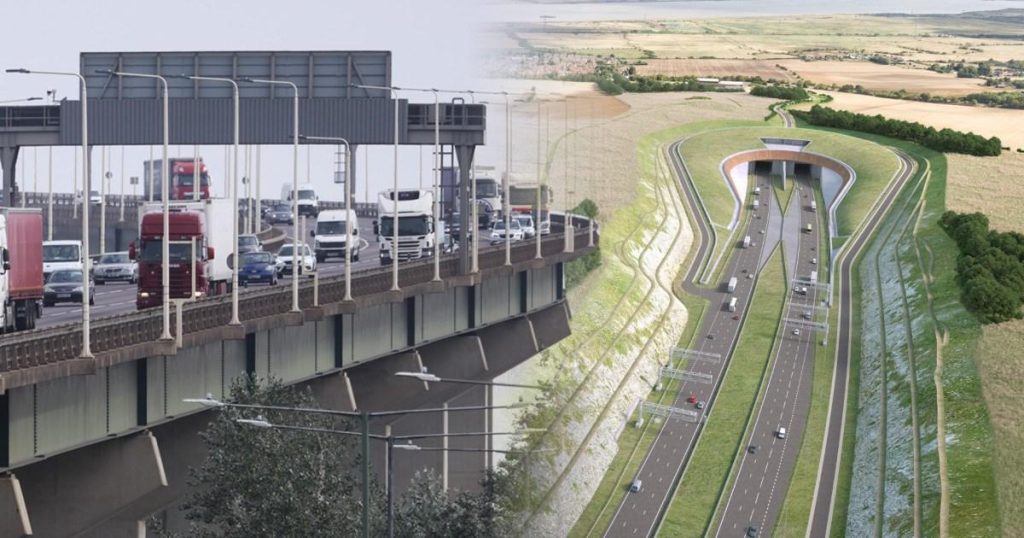The Dartford Crossing, a critical bridge spanning the River Thames and connecting the M25 motorway to Essex and Kent, has become notorious as the UK’s largest traffic bottleneck. Handling an average of 150,000 vehicles daily, the crossing significantly exceeds its original capacity by 20,000, leading to frequent and extensive traffic jams. This congestion has spurred urgent calls for a second Thames crossing to alleviate the pressure on Dartford and improve traffic flow in the region. National Highways and local proponents advocate for the Lower Thames Crossing, a project envisioned to divert traffic east of Dartford and address the current imbalance in river crossings, with only one existing east of London compared to 16 west of the city.
The Lower Thames Crossing project, initially conceived in 2009, has faced repeated delays, most recently with the government’s planning decision postponed until May 2025. This postponement has fueled debate, with sustainable transport advocates calling for the project’s abandonment due to environmental and cost concerns, while local residents and businesses eagerly anticipate its construction, viewing it as a crucial solution to the crippling traffic woes. Dartford’s MP, Jim Dickson, has been a vocal supporter, highlighting the crossing’s vulnerability as a single point of failure and the detrimental impact of its disruptions on both regional logistics and the daily lives of Dartford residents. He emphasizes the project’s potential to alleviate traffic congestion, create jobs, and stimulate the UK economy.
The detrimental effects of Dartford’s congestion are palpable. Incidents like lorry fires and oil spills can cripple the crossing, resulting in hours-long delays for motorists. The crossing’s importance to the UK economy is underscored by the fact that it carries over 50 million vehicles annually, with 40% being goods vehicles, and serves as a vital artery for port freight. Recent incidents, including erroneous Dart Charge penalties levied on drivers who hadn’t even used the crossing and a Christmas-time closure due to a tanker fire, further underscore the crossing’s vulnerability and the urgent need for a viable alternative.
Despite the perceived need for the Lower Thames Crossing, opposition remains significant. The Transport Action Network, advocating for sustainable transport, argues that the project, even if approved and completed by 2032, would offer only a temporary reprieve from congestion at Dartford, while simultaneously exacerbating carbon emissions. This stance clashes with the government’s commitment to substantial investment in emissions reduction initiatives. Local businesses, however, paint a different picture, emphasizing the crippling impact of Dartford’s congestion on their operations and daily commutes. Dennis Mehmed, a local business owner, recounts how his daughter was trapped in traffic for four hours for a journey of less than 20 miles due to gridlock at Dartford. He, like many others, views the Lower Thames Crossing as an essential infrastructure improvement, crucial for the region’s economic vitality and residents’ quality of life.
The sheer scale of the Lower Thames Crossing project is reflected in its record-breaking planning application, totaling over 359,000 pages. This complexity, coupled with the ongoing debate surrounding its environmental and economic impact, contributes to the protracted decision-making process. The project’s fate remains uncertain, with the final decision delayed until May 2025. This delay further underscores the challenging balance between addressing urgent infrastructure needs and mitigating potential environmental consequences. Meanwhile, the spotlight remains on London’s crossings, as the upcoming opening of the Silvertown Tunnel and the associated tolls introduce another dimension to the city’s complex transportation landscape.
The debate surrounding the Lower Thames Crossing highlights the multifaceted challenges inherent in large-scale infrastructure projects. Balancing the urgent need for improved traffic flow, economic development, and environmental protection requires careful consideration and robust planning. While proponents argue for the project’s economic benefits and its potential to alleviate chronic congestion, opponents raise concerns about its environmental impact and long-term effectiveness. The extended planning process, punctuated by delays and public discourse, underscores the complexity of the issue and the importance of finding a solution that addresses both immediate needs and long-term sustainability. As the final decision looms, the future of the Lower Thames Crossing remains uncertain, leaving residents, businesses, and environmental advocates alike to await the outcome with bated breath.


